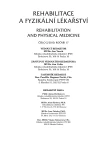Results of Physiotherapy According to „Ostrava Concept” in Female Patients with Urine Incontinence
Authors:
R. Holaňová 1; J. Krhut 2; K. Hegedüsová 1; M. Gärtner 3; J. Tvrdík 4
Authors‘ workplace:
Klinika léčebné rehabilitace FN Ostrava - Poruba
přednosta MUDr. I. Chmelová Ph. D
1; Urologické oddělení FN Ostrava - Poruba
přednosta doc. MUDr. J. Krhut, Ph. D
2; Gynekologicko-porodnická klinika FN Ostrava - Poruba
přednosta MUDr. O. Šimetka
3; Katedra informatiky a počítačů, přírodovědecká fakulta Ostravské univerzity, Ostrava
vedoucí doc. Ing. C. Klimeš, CSc.
4
Published in:
Rehabil. fyz. Lék., 17, 2010, No. 2, pp. 63-66.
Category:
Original Papers
Overview
Introduction:
Urine incontinence belongs to most frequent medical problems especially in the female population, where it affects hundreds of millions of people. Although it is not associated with a high morbidity of mortality, it significantly influences quality of like of the affected patients.
The paper evaluates the effect of physiotherapy performed according to the “Ostrava concept” by means of subjective and objective parameters including the effect on quality of life in a group of women with urine incontinence.
Material and methods:
In the observed group 159 female patients with urine incontinence of seriousness grade I or II were enrolled (stress incontinence, hyperactive bladder, mixed incontinence). The mean age of the group was 53.4 years (19-80). All patients were treated by a complex physiotherapy according to the “Ostrava concept”. The resulting effect of the conservative therapy was evaluated by two subjective parameters and one objective parameter. The subjective effect of therapy was evaluated by visual-analogous scale of complaints caused by the incontinence (VAS) and an I-QoL questionnaire of the quality of life. The selected objective parameter was the measurement of the strength of muscles of pelvic floor using the Peritron perineometer. The evaluation was performed before inhibition of therapy and six months after its end. The results were evaluated by the pair t-test and the Wilcoxon text.
Results:
The VAS value before the treatment was 5.93, and it decreased to VAS value of 2.68 after 6 months of therapy (p 0.005). The quality of life index before the treatment in our group was 52.67 and it increased after the treatment to 70.06 (p 0.005).
The value of maximum contraction of pelvic floor muscles before the treatment was 19.84 cm H2O and it increased after therapy to 22.21 cm H2O (p 0.05), the medium value of contraction of pelvic floor muscles before the treatment was 13.37 cm H2O and 16.34 cm H2O after the therapy (p 0.005), the mean duration of maximum contraction of pelvic floor muscles before the therapy was 5.09 s and 9.21 after the therapy (p 0.005).
Conclusion:
Based on the results obtained the complex physiotherapy can be evaluated as an effective treatment of incontinence of seriousness grade I or II. In view of the noninvasive character and absence of undesirable effects it should be considered as the treatment of first choice in patients with urine incontinence.
Key words:
stress incontinence, overactive bladder, quality of life, pelvic floor muscles, conservative therapy, pelvic floor exercise, bladder training
Sources
1. ALHASSO, A. A., MCKINLAY, J., PATRICK, K. et al.: Anticholinergic drugs versus non-drug active therapies for overactive bladder syndrome in adults. Cochrane Database Syst. Rev., 18, 2006, 4, CD003193.
2. ABRAMS, P., CARDOZO, L., KHOURY, S., WEIN, A. (Ed.): Incontinence. Paris, Health Publication Ltd., 2005, s. 1677.
3. ABRAMS, P., WEIN, A. J.: The overactive bladder: from basic science to clinical management. Urology, 50, 1997 (Suppl. 6) s. 1-3.
4. BERGHMANS, L. C., HENDRIKS, H. J., DE BIE, R. A. et al: Conservative treatment of urge urinary incontinence in women: A systematic review of randomized clinical trials. BJU Int., 85, 2000, 3, s. 254-263.
5. CHAPPLE, CH., CARDOZO, L.: Mixed incontinence supplement. Eur Urol., 16, 2006, (Suppl. 5) s. 835-836.
6. HAHN, I., SOMMAR, S., FALL, M.: Urodynamic assesment of pelvic floor training. World J. Urol., 9, 1991,s. 162-166.
7. HOLAŇOVÁ, R., KRHUT, J., MUROŇOVÁ, I.: Palpační vyšetření svalů pánevního dna, Rehabil. fyz. Lék., 14, 2007, s. 87-90.
8. KEGEL, A. H.: Physiologic therapy for urinary stress incontinence. J. Am. Med. Assoc., 146, 1951, 10, s. 915-917.
9. KRHUT, J., HOLAŇOVÁ, R., MUROŇOVÁ, I.: „Ostravský koncept“ fyzioterapie v léčbě močové inkontinence. Rehabil. fyz. Lék., 12, 2005, s. 122-128.
10. MILLER, J., ASHTON-MILLER, J., DE LANCEY, J. O. L.: The Knack: use of precisely-timed pelvic muscle contraction can reduce leakage in SUI. Neurourol. Urodyn., 15, 1996, s. 392-393.
11. WAGNER, T. H., PATRICK, D. L., BAVENDAM, T. G., MARTIN, M. L., BUESCHING, D. P.: Quality of life of persons with urinary incontinence: development of a new measure. Urology, 47, 1996, s. 67-72.
12. WALLACE, S. A., ROE, B., WILLIAMS, K., PALMER, M.: Bladder training for urinary incontinence in adults. Cochrane Database Syst. Rev., 2004, 1, CD001308.
Labels
Physiotherapist, university degree Rehabilitation Sports medicineArticle was published in
Rehabilitation & Physical Medicine

2010 Issue 2
- Hope Awakens with Early Diagnosis of Parkinson's Disease Based on Skin Odor
- Deep stimulation of the globus pallidus improved clinical symptoms in a patient with refractory parkinsonism and genetic mutation
Most read in this issue
- Hallux Valgus from the Physiotherapist Standpoint or Is Hallux Valgus Just a Hallux Deformity?
- Evaluation of Motoric Defects in Childhood
- Effects of Treatment with Biosynchron 500 on Motor a Non-motor Symptoms in Patients with Parkinson Disease – Results of a Randomized Study
- Organization of Rehabilitation with Use of ICF (International Classification of Functioning, Disability and Health WHO), Assessment of Degrees of Disability According to Qualifiers)
